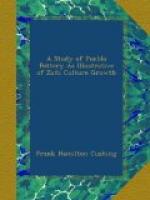We may see, finally, how at last the canons proved too limited and in other ways undesirable for occupation, the result of which was the confederation of the scattered cliff-dwelling clans, and the construction, first on the overhanging cliff-tops, then on mesas, and farther and farther away, of great, many-storied towns, any one of which was named, in consequence of the bringing together in it of many houses and clans, thlu el lon ne, from thlu a, many springing up, and el lon a, that which stands, or those which stand; in other words, “many built standing together.” This cannot be regarded as referring to the simple fact that a village is necessarily composed of many houses standing together. The name for any other village than a communal pueblo is ti na kwin ne, from ti na—many sitting around, and kwin ne, place of. This term is applied by the Zunis to all villages save their own and those of ourselves, which latter they regard as Pueblos, in their acceptation of the above native word.
Here, then, in strict accordance with, the teachings of myth, folk-lore and tradition, I have used the linguistic argument as briefest and most convincing in indicating the probable sequence of architectural types in the evolution of the Pueblo; from the brush lodge, of which only the name survives, to the recent and present terraced, many-storied, communal structures, which we may find throughout New Mexico, Arizona, and contiguous parts of the neighboring Territories.[1]
[1] See for confirmation the last Annual Report to the Archaeological Institute of America, by Adolph F. Bandelier, one of the most indefatigable explorers and careful students of early Spanish history in America.
POTTERY AFFECTED BY ENVIRONMENT.
There is no other section of the United States where the potter’s art was so extensively practiced, or where it reached such a degree of perfection, as within the limits of these ancient Pueblo regions. To this statement not even the prolific valleys of the Mississippi and its tributaries form an exception.
On examining a large and varied collection of this pottery, one would naturally regard it either as the product of four distinct peoples or as belonging to four different eras, with an inclination to the chronologic division.
When we see the reasonable probability that the architecture, the primeval arts and industries, and the culture of the Pueblos are mainly indigenous to the desert and semi-desert regions of North America, we are in the way towards an understanding of the origin and remarkable degree of development in the ceramic art.




